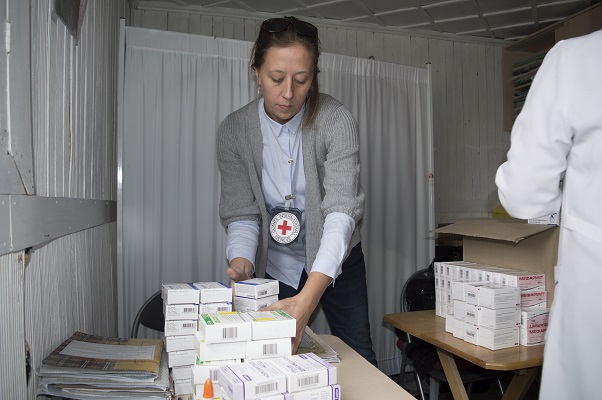Non-communicable diseases (NCDs) have proven a tricky thing for humanitarian agencies. Difficult to identify in the midst of crisis, it is increasingly difficult to ignore these underlying diseases and their immense health costs that increase vulnerabilities in emergencies as well as in ordinary life.
A new initiative seeks to solve this problem by finding some very specific solutions to some very specific problems.The project grew out of an informal working group on non-communicable diseases involving the ICRC, MSF, UNHCR, WHO and others.
“As these conditions are chronic in nature, they require longer-term approaches which can be a challenging task for organizations that are more accustomed to dealing with acute emergencies,” says Stephanie Cristin, health innovation and partnerships advisor at the ICRC.
Seeking the long-term amid the short-term
Humanitarians tend to focus on rapid, life-saving interventions for acute problems – treating wounds, managing disease outbreaks, providing food, water and shelter. But shifts in epidemiology, an increasing burden of disease and crises that are increasingly complex and protracted mean that chronic illnesses must not be put on the backburner.
“There was a recognized need among the working group to better cater to NCDs although we all realized that we’re not entirely prepared to do so,” says Cristin.
Once this need was identified, guidelines had to be formulated for managing the treatment of chronic illnesses within emergency operations. But then came the hard part: finding the solutions. The entry point was diagnostics because they can reveal the presence of the disease, and the pathway to its treatment.
Knowing they could not go it alone, the humanitarian organizations widened their conversation to include the Foundation for Innovative New Diagnostics (FIND), a Geneva-based non-profit focused on diagnostics and testing in global health.
These kinds of partnerships particularly resonate with ICRC’s Innovation approach to include new, more diverse collaborations that can produce concrete and far-reaching solutions.
Fresh focus
Like humanitarians, scientists had mostly focused on infectious diseases – such as tuberculosis, malaria, hepatitis and myriad neglected tropical diseases. This has changed in recent years with the realization that infectious and non-communicable diseases are entangled.
“They’re not parallel,” says Beatrice Vetter, scientific officer at FIND and lead of the organization’s work on non-communicable diseases. “People with non-communicable diseases are disproportionately affected by infectious diseases and vice versa. There are numerous examples of that, the most recent one being COVID-19.”
Catharina Boehme, CEO of FIND, explains that they started working with humanitarian organizations to combat this double burden, which can be especially devastating in low- and middle-income countries where appropriate patient management is not always available or accessible.
“With risk factors for non-communicable diseases on the rise due to changes in diet and living standards – and COVID-19 making access to care even more challenging – there is an urgent need for patient-centered approaches to healthcare. That starts with ensuring that primary healthcare facilities are capable of addressing diagnosis and monitoring of both infectious and non-communicable diseases at the point of care.”
The first set of targets were some of the most common diseases that people live with around the world, whether in the most stable of states or the deepest of crises: cardiovascular diseases (CVDs), diabetes, chronic respiratory diseases (CRDs) and cancers. Of these, the first two were chosen as the starting point for the move into non-communicable diseases.
And for this, pinpointing the gaps was crucial.
Cheaper, simpler, better
The diagnostic tools for diabetes already exist, the problem is access, which really means cost. Glucose test strips are readily available in wealthy countries. But in low-and-middle-income countries they can be often difficult to come by in primary health facilities and remain a rarity in patients’ hands.
“We are working on identifying suitable manufacturers of high-quality products to see if we can come to a preferential agreement on prices and service delivery,” says Vetter.
For cardiovascular diseases, it is a question of technological innovation, a need to bring together several discrete diagnostic tools into a single simple, hardwearing and affordable device. This process of identifying and defining what is needed is known as establishing a target product profile, a baseline for what kind of cardiometabolic platform would best fit the humanitarian purpose.
“We’re not trying to develop a new product,” says Cristin, “we need an adaptation of an existing solution.”
For example, the tool might need to be battery-powered in case of power outages, able to withstand extreme climatic conditions such as heat and dust and be easy to use. Existing tools that broadly fit the criteria will be field tested before the process of adapting and improving can begin.
Better solutions, new markets
The motivation for humanitarians to strive for better diagnosis and improved healthcare is self-evident, but what’s in it for the private sector?
Different manufacturers have different motivations. Bigger manufacturers want to maintain market share, while smaller ones are seeking new points of entry. For both, a coalition of humanitarians seeking similar tools for use in lower income and crisis-hit countries represents a new opportunity to reach government and private sector buyers in a different marketplace.
Glucose test strips cost upwards of $0.16 each – and more commonly double or triple that – so the hope is to work with private sector partners to bring the price down in a sustainable manner. This would mean big savings for patients, clinics, hospitals and governments, big increases in test frequency for people living with diabetes, and opportunities for more manufacturers to enter the market.
The cardiometabolic platform is further off, but the working group is confident the humanitarian and private sector partners will, together, be able to identify gaps in the existing technology and work together to improve features, adapting them for the specific challenges of humanitarian work.
- Discover more examples of health care innovations

